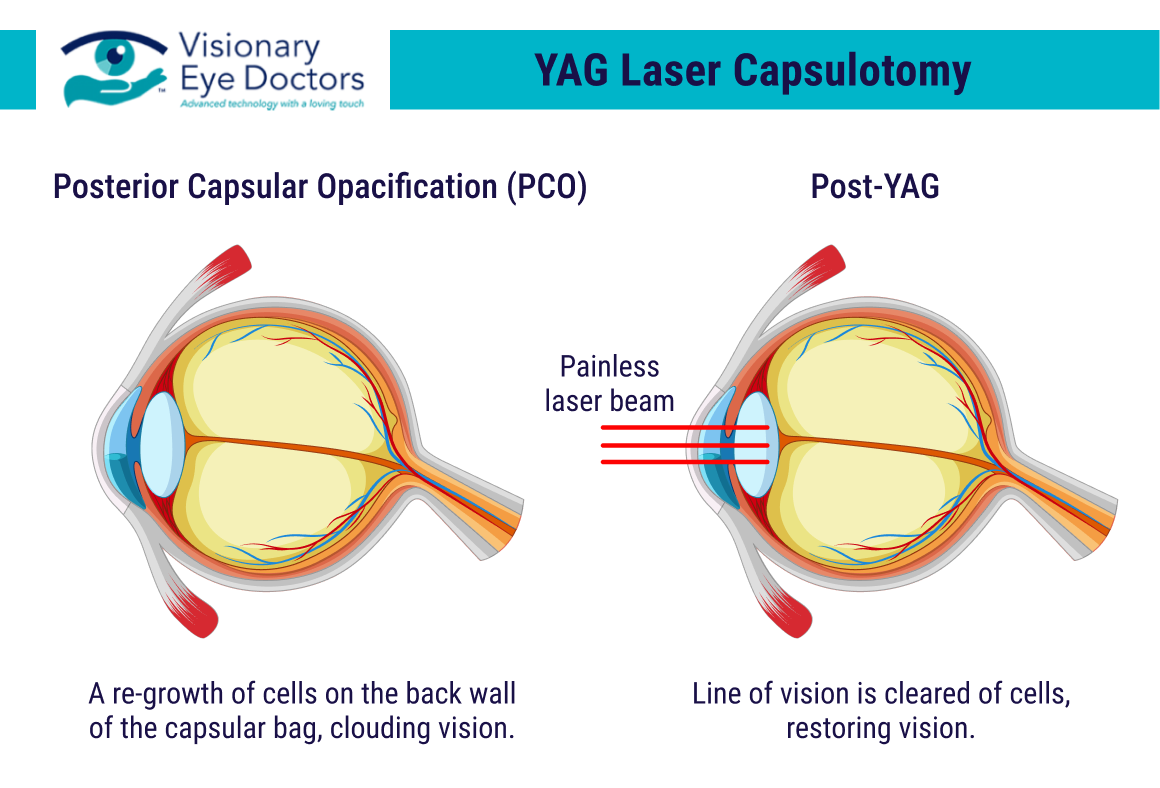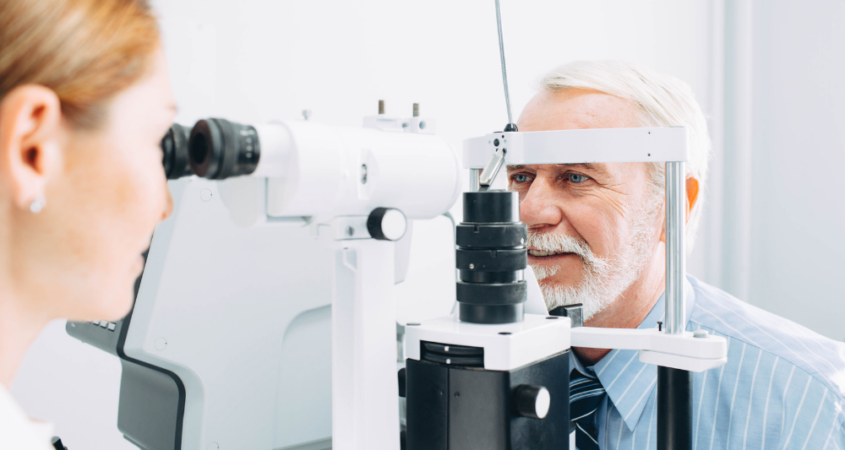How Soon After Cataract Surgery Can YAG Laser Be Done? An Explanation of This Life-Changing Procedure
Do you remember the joy you felt when you were able to see clearly after your cataract surgery? It was like seeing the world again in HD resolution. Not just colors, but objects, faces, words – everything seemed sharper, more defined.
However, many patients start experiencing unclear or blurry vision a few months after the surgery, even after a successful cataract operation. If you are one of them, know that this is a common occurrence that is easily treatable. The solution is a procedure called YAG Laser capsulotomy.
At Visionary Eye Doctors, we continually strive to simplify eye health for our patients. By investing in patient education, we hope to make sure you understand not just what’s happening to your eyes, but also the why and how behind each treatment plan. Our team consists of highly skilled professionals, each of them committed to helping you see better and lead a happier life.
But what is a YAG laser capsulotomy?
Medically termed as Yttrium Aluminum Garnet (YAG) laser capsulotomy, this non-invasive surgical procedure is primarily utilized to enhance vision in patients who might develop cloudy vision or experience visual disturbances following cataract surgery. This issue can arise due to a condition called Posterior Capsule Opacification (PCO), commonly referred to as secondary cataract.
Over the upcoming sections, we will dive into the specifics of YAG laser capsulotomy, unraveling what it is, the reasons you might need it, how it’s done, and what to expect after the procedure. Today’s primary focus is to answer a question we often get asked in our practice: “How soon after cataract surgery can YAG laser be done?” So, let’s dive into the topic.
Explanation of YAG Laser Capsulotomy
When we have a conversation about eye health, it’s crucial to understand the causes and treatments of various conditions involved. To help you get a handle on why you might need a YAG laser capsulotomy after your cataract removal, we can start by explaining secondary cataracts.
First and foremost, secondary cataracts are not new cataracts. Following a cataract surgery, your natural lens is substituted with an intraocular lens, a transparent artificial lens. In some patients, certain remaining epithelial cells migrate and reproduce on the back, or posterior capsule, of the artificial lens. This leads to a condition known as Posterior Capsule Opacification (PCO), frequently referred to as a secondary cataract. It’s marked by the thickening and clouding of the lens capsule.
This vision impairment is more common than you may think, and it’s in no way a sign of an unsuccessful cataract surgery. In fact, almost 20% of cataract surgery patients require a YAG capsulotomy, typically several months after the initial surgery. Many patients often describe their symptoms as similar to a recurrence of the original cataract – cloudy vision, less vivid color perception, and problems with glare and light scattering.
Luckily, we have YAG laser capsulotomy to reverse these effects. This procedure is designed to clear up your vision by creating a small hole in the cloudy posterior lens capsule, allowing light to pass through the lens correctly once more.
It’s called YAG laser capsulotomy due to the Yttrium Aluminium Garnet laser utilized in the treatment. The laser is highly precise, and it enables your eye surgeon to clear the cloudy vision without causing damage to other structures of the eye.
Ultimately, YAG laser capsulotomy is a strategic intervention that improves patients’ vision, addressing one of the most common aftereffects of cataract surgery. Now that we have a basic understanding of what YAG laser capsulotomy is, in the next section, we will discuss the timeline and procedure of this laser treatment.
Procedure and Timelines in YAG Laser Capsulotomy

So, how soon after your cataract surgery can a YAG laser capsulotomy be performed? Typically, doctors recommend a waiting period of at least a few months following your initial cataract surgery before considering a YAG laser capsulotomy. This allows your eye to recover and adapt to the new intraocular lens. Furthermore, it provides ample time to ensure that the symptoms aren’t temporary or part of the healing process post-surgery.
Now, let’s talk about what happens during a YAG laser procedure. The procedure itself is relatively straightforward and is usually performed as an outpatient procedure, meaning you can go home the same day.
After numbing your eyes with eye drops, your eye doctor utilizes the YAG laser to focus short bursts of light energy on the posterior capsule, where the PCO has occurred. This laser energy creates a small opening in the cloudy lens capsule, allowing light to pass through unimpeded, thereby restoring your visual acuity.
The procedure is quick – often taking only a few minutes – and generally painless. However, you might feel a slight sensation of pressure in your eye when the laser is activated.
Post the YAG capsulotomy, you’ll likely notice improvements in your vision almost immediately or within a few hours. Most patients can resume their normal activities on the day following the procedure. However, it’s recommended that you have someone drive you home on the day of the surgery for your safety.
But while the YAG laser capsulotomy is a relatively simple procedure, like any surgical intervention, it’s not without risks. It’s essential to become thoroughly acquainted with these, and that’s what we discuss in the subsequent section.
Risks and Post-Procedure Care
As with any procedure involving the eyes, having concerns is understandable. Therefore, it’s important that we cover some potential risks with the YAG laser procedure. While side effects are not common, they can occur. Side effects can include short-term increased intraocular pressure, macular edema, retinal detachment, and in rare cases, damage to the intraocular lens. In rarer cases, one may experience symptoms of capsular block syndrome, such as inflammation, pain, and decreased visual acuity.
In the event you experience what seems like sudden flashes of light, an increase in floaters (small specks that appear to drift across your visual field), or a sensation like a curtain has been drawn over one eye, you should seek immediate medical attention. These could be signs of retinal detachment, a severe but rare side effect that requires urgent treatment.
Rest assured that complications after a YAG laser procedure are uncommon. Most patients report significant improvement in their vision soon after the procedure, and serious complications are, indeed, rare.
Post-procedure care following a YAG capsulotomy is typically stress-free. You might be prescribed anti-inflammatory eye drops to help reduce inflammation and maintain comfort in the treated eye. It’s essential to use them as directed by your eye surgeon.
You will also need to schedule a follow-up appointment with your eye care provider a couple of hours post-procedure to check your eye’s response to the treatment and to monitor your intraocular pressure. Ensuring your eyes are healing as expected is crucial and will assist in identifying and dealing with any potential complications promptly.
At Visionary Eye Doctors, we maintain diligent post-operative care and ensure that each patient gets the attention they deserve, with a focus on continuous communication and timely interventions if required.
Harnessing the Power of YAG Laser Capsulotomy: Your Path to Clear Vision Post-Cataract Surgery
In conclusion, cataract surgery has the power to transform your view of the world in spectacular fashion. However, it’s not uncommon for some patients to encounter a few bumps on the road to crystal-clear vision. One such bump is the occurrence of Posterior Capsular Opacification (PCO), also known as secondary cataracts. This situation calls for a procedure known as YAG laser capsulotomy, a quick, non-invasive treatment performed a few months after the initial cataract surgery.
We hope this piece has helped clarify how soon after cataract surgery a YAG laser can be done, the nature of the process, and what to expect after the procedure is performed. Though the thought of another procedure might initially feel overwhelming, it’s essential to remember that it’s a regular part of the journey towards perfect vision for some people. Most importantly, the procedure is safe, swift, and capable of bringing an impressive improvement in visual acuity.
As with every health journey, the success and safety of the treatment lie in the expertise and knowledge of your doctor and the quality of post-operative care. This is why we offer comprehensive client support at Visionary Eye Doctors, ensuring our patients are thoroughly informed, feel confident, and are well-taken care of throughout their eye health journey.
We encourage everyone who has undergone cataract surgery and is enduring unclear vision to reach out and have it checked. On the other hand, if you’re considering cataract surgery, remember that we’re here to guide you through each step from preparation to post-procedure care, making sure that your journey to better vision is as smooth as possible.
Your clear vision is our passion and priority. Reach out to us today, and let’s embark on the eye health journey together.
Schedule an appointment with Visionary Eye Doctors in Rockville, MD, today and take the next steps towards a clearer tomorrow.




